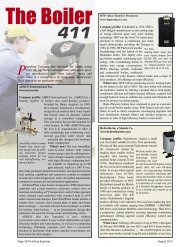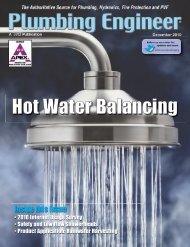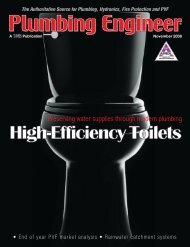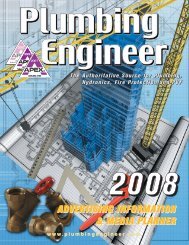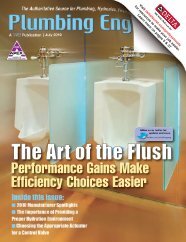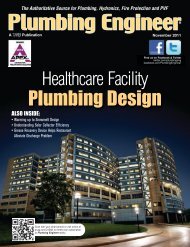open issue - Plumbing Engineer
open issue - Plumbing Engineer
open issue - Plumbing Engineer
You also want an ePaper? Increase the reach of your titles
YUMPU automatically turns print PDFs into web optimized ePapers that Google loves.
Some newer lavatories utilize photovoltaic technology,<br />
which converts restroom lighting to energy to activate<br />
the flow of water, eliminating the need for batteries and<br />
electricity.<br />
gpm to 2.2 gpm; however, many public restrooms use<br />
just 0.5 gpm. Some newer-generation touchless fixtures<br />
feature 0.38 gpm faucets vs. 0.5 gpm, and achieve over<br />
20% water savings. In any case, fixtures using less than<br />
the 2.5 water conserving gpm standard can help earn<br />
LEED credit.<br />
Toilets: Low-flow toilet fixtures using 1.6 gallons or<br />
less, or urinals using 0.5 to 1.0 gallons, have become the<br />
standard in commercial facilities. One-pint urinals and<br />
waterless urinals have made strides in recent years. Lowflow<br />
fixtures can be complemented with standard-flow<br />
fixtures such as dual-flush toilets, which conserve water<br />
by using different amounts of water for various flushing<br />
needs. Some newer technologies have sensors to determine<br />
the size of flush by measuring the time a user<br />
spends at the toilet in addition to the user’s distance from<br />
the toilet.<br />
Photovoltaics: Photovoltaic cells integrated into the<br />
top of a lavatory system convert either normal restroom<br />
lighting or day lighting into energy that is stored and<br />
used to power valves and sensors in the units. Some fixtures<br />
even eliminate the need for batteries and electrical<br />
hookups, therefore cutting maintenance and operating<br />
costs and maximizing savings and environmental efficiency.<br />
Vandal-resistance: Capacitive sensing uses an omnidirectional<br />
zone to detect a user’s presence around the<br />
entire faucet spout in place of a small infrared sensor<br />
window under the spout, which can be punctured or covered<br />
with soap scum that can interfere with the sensor<br />
window. These units are virtually vandal-free and maintenance-free,<br />
since the mechanicals are safely concealed<br />
in a sealed control box.<br />
Washroom Accessories: Touchless hand dryers,<br />
paper towel dispensers and soap dispensers also underscore<br />
energy and environmental efficiencies and convenience<br />
for users and maintenance staff. More recent<br />
automatic hand dryer designs have made some key<br />
advances. Some energy-efficient, sensor-operated hand<br />
dryers use 80 percent less electricity than other hand dryers.<br />
The energy to operate this new generation of hand<br />
dryers is generally less than 10 percent of the cost of<br />
paper towels, including eliminating labor costs for ordering,<br />
storing, replenishing dispensers, collecting and disposing<br />
of paper towels.<br />
Touchless, forced-air hand dryers feature infrared sensors<br />
that activate the dryer when hands are placed three<br />
to six inches below the nozzle. Improved units dry hands<br />
in 15 seconds and are designed to automatically adjust<br />
voltage to all power conditions.<br />
In general, electric hand dryers are an environmentally<br />
friendly choice over paper towels, because they conserve<br />
resources and use relatively little electricity, while<br />
offering the hygienic benefit of operating automatically<br />
and promoting a cleaner restroom appearance, since<br />
paper towel debris is eliminated.<br />
Hands-free soap dispensers also reduce the number of<br />
germs on surfaces. If the soap dispenser is integrated into<br />
the lavatory, users never have to remove their hands<br />
from the bowl. That reduces the amount of water pooling<br />
on countertops and potentially dangerous drips on floors.<br />
Employing the latest models of hands-free restroom<br />
fixtures gives building management and patrons alike the<br />
best of all worlds — from saving water, energy and<br />
money to providing healthier, more convenient and more<br />
hygienic environments. n<br />
Jason Renner is a senior product manager at Bradley<br />
Corporation of Menomonee Falls, Wis. A USGBC member<br />
and manufacturer of locker room products, plumbing<br />
fixtures, washroom accessories, partitions and emergency<br />
fixtures, Bradley serves the commercial, industrial,<br />
health care, recreation, education and corrections<br />
markets worldwide. Renner can be reached at Bradley<br />
Corp., W142 N9101 Fountain Blvd., Menomonee Falls,<br />
Wis., 53052-0309. For more information, call 800/<br />
BRADLEY or visit www.bradleycorp.com.<br />
The newest generation of touchless adjustable speed hand<br />
dryers uses 80 percent less electricity than other popular<br />
hand dryers. These dryers offer the option to choose preferred<br />
air speed and sensor range, allowing hands to dry in<br />
as little as 10 seconds.<br />
<strong>Plumbing</strong> <strong>Engineer</strong> April 2012/Page 45




